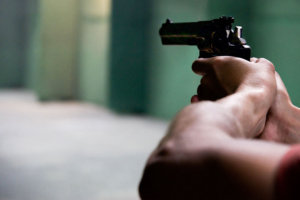Is it better to keep a gun on a leash?
 When I hold you in my arms — oh yeah
When I hold you in my arms — oh yeah
And I feel my finger on your trigger — oh yeah
I know nobody can do me no harm — oh yeah
Because, happiness is a warm gun
Happiness is a Warm Gun, The Beatles
Well, I’m on my gun pitch again; this time after reading an article in the October 2021 Atlantic magazine. Titled “Dispatches,” author David Frum argues that, “Responsible gun ownership is a lie.” While Americans covered pandemic needs with purchases that allowed them to live crowd free—things such as toilet paper, food, clean water, etc.— they also increased their purchase of guns dramatically. More than 23 million firearms were purchased—a gain of 65 % over the previous year. And things have not slowed down. In January, Americans bought another 4.3 million guns, setting a monthly record.
As I said in a previous Out Takes, I grew up in a gun-bearing family. My father hunted ducks and geese on a lake in southern Minnesota. On weekend mornings we would hunker in a duck blind, shivering in usually cold middle-to-late October. Most of the day we would hope the batteries would not give out on our portable radio so we could hear what the Golden Gophers were doing on the football gridiron.
The lake was shaped like an hourglass, and, periodically, the ducks would migrate from one globe to the other. Our blind was on a point sticking into the middle of the hourglass. Another family owned a similar point across from us, and as the ducks took flight, they or we would shout to the other point dwellers, “North!” or “South!” (It mattered not the least whether the Gophers were about to score that winning touchdown for the “Little Brown Jug.”) Canvas backs and red heads were the important matters of the moment. And they were not dummies themselves. They knew to stay high and above range of our shotguns until they had reached the other end of the lake. Most would make their flight unscathed.
The Atlantic article says that weapons are not being bought largely for hunting, however. Roughly 11 and one half million Americans hunt in a year. Militia members are not the major purchasers either. The most often purchased gun is the modern semi-automatic handgun, and, according to buyers, most are purchased to protect themselves and their families. However, according to the article, in almost every way possible, the purchase makes the family less safe.
Dick’s Sporting Goods has reduced its over-the-counter sales of guns dramatically in the last three years. It began by a 10-store test, which was followed by an additional 125 stores in 2019—2020 saw 440 more of their stores stop selling guns.
Let me take guns a bit closer to home, particularly when I was growing up. My dad was both a duck hunter and a trap shooter, an active member of the local gun club where he could hang out Sunday mornings so he would not have to attend church.
As I said above, we owned a blind on a lake that had belonged to my grandfather. He no longer hunted, but used the cabin to get away from home on weekends. He would build a fire and fix a hot lunch while the ducks flew. Those duties kept him active and aware what was happening on his lake.
Guns also had a gender bias. They were almost strictly men’s tools. Looking at the skeet and trap ranges at the local gun club, it showed a male predominance. This was the 1950s and early 1960s when that predominance revolved around an influential stance over other men. Men fought wars. Women washed dishes.
Guns were symbols until they were put into use against others. That is the point at which, according to Frum, “so many Americans are deceived by so many illusions about what a gun will do for them.” Shooting ducks and geese for food is one thing. Shooting people for many different reasons—many of them insane—is quite another.
The late John Lennon and his cronies probably came as close to the truth, hinting that human nature is indeed theater of the absurd when we claim that happiness is most of all a warm gun.
There you are—“Bang, Bang, Shoot, Shoot.”

